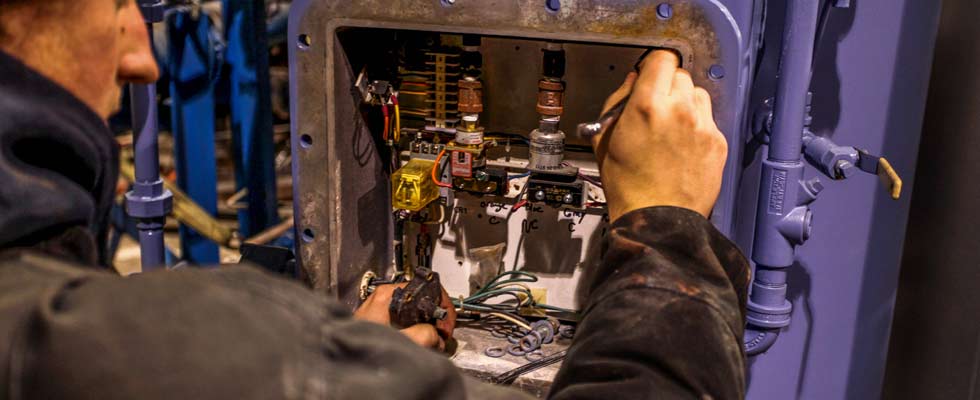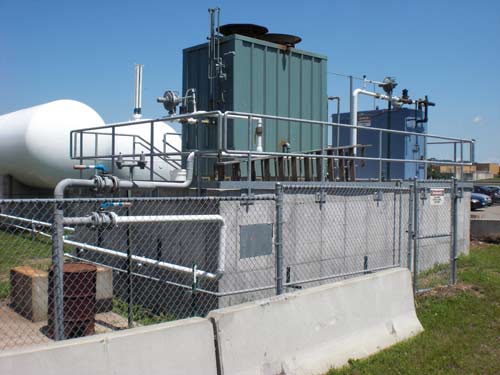
Recent weather events have highlighted the need for energy backup systems beyond the reason of a lower-cost gas rate. The push to convert coal-fired electric plants to natural gas has magnified the need for more gas supply and contributed to limited supplies in some areas that previously did not have that load.
The additional dependence on bringing wind generation online to supplement the grid hasn’t always panned out. Abnormally cold weather can render wind turbines useless.
During recent cold snaps, propane suppliers received emergency calls from companies that needed help with backup systems for natural gas. These backup systems are also called synthetic natural gas (SNG) systems. Propane and air are blended together at a prescribed ratio so that it looks like natural gas to the furnace or boiler’s burner tips. It can be switched to run on SNG without any changes to the orifices — it is a matter of turning on a valve and pushing a button.
 SNG is a proven technology, as it has been used for many years by utilities as a way of injecting gas in a pipeline during peak demand times. Hospitals and other large gas users are accustomed to it in the northern tier of the country.
SNG is a proven technology, as it has been used for many years by utilities as a way of injecting gas in a pipeline during peak demand times. Hospitals and other large gas users are accustomed to it in the northern tier of the country.
Beyond providing the needed redundancy, our local natural gas suppliers give a special discounted gas rate if you have an SNG system because it allows them more control over their gas allocation with a finite amount of supply in the pipelines.
Medical and critical manufacturing facilities need to have their backup systems consistently checked. Hospitals are required to have systems and procedures in place to ensure patients have the needed energy.
Three years ago, a small hospital inquired about a backup system replacement because its backup system was not working and had fallen into disrepair. If a propane equipment supplier is in the middle of curtailments and its maintenance crews are working overtime, it is hard to respond favorably to surprise requests.
A nuclear waste processor located in Tennessee had a dilemma just before Christmas four years ago. Someone had cut the gas line in a construction accident, and the processor was without gas to keep it in business. There was a backup system in place, but it hadn’t run for quite a while and wasn’t working. And of course, it happened the weekend before Christmas.
Why do your customers need a backup system, and especially one that works reliably? It depends on what the company does. Can it afford to be without gas for a week or two? Does it want options when natural gas rates go too high? Does the company want the energy independence to not be concerned with the weather or potential accidents? Think of a standby or backup system like insurance. It is nice to have it for peace of mind, but you hope you never have to use it.
 Pipeline infrastructure can be somewhat limited in certain parts of the country. It was designed for a certain maximum gas load. As businesses expand in some areas, there is not enough gas to allocate to the new business. By having an SNG system, it can be used for peak shaving locally when the business needs additional gas for short periods of time. Such is the case for a local grain elevator with huge dryers running during harvest times. There may be natural gas running to the location, but there might not be enough natural gas during peak usage. A backup SNG system is perfect to supply the necessary peak demand.
Pipeline infrastructure can be somewhat limited in certain parts of the country. It was designed for a certain maximum gas load. As businesses expand in some areas, there is not enough gas to allocate to the new business. By having an SNG system, it can be used for peak shaving locally when the business needs additional gas for short periods of time. Such is the case for a local grain elevator with huge dryers running during harvest times. There may be natural gas running to the location, but there might not be enough natural gas during peak usage. A backup SNG system is perfect to supply the necessary peak demand.
An annual preventive maintenance contract should be strongly considered to keep the system maintained, because well-maintained equipment is more reliable. A maintenance contract will ensure the system is ready to go for the heating system and properly shut down for the summer.
Keep in mind that things may work well on a nice, fall day when the system is checked out, but when the temperature drops to 20 degrees below zero, there may be problems. A contract ensures that your company is on the priority list when the phones start ringing in January during a curtailment.
How is an SNG system structured? What are the main elements of the system? The largest thing you would see is a propane tank. Sizes vary, but propane is cheaper when delivered in transport-sized loads of about 10,000 gallons.
A typical small tank is 1,000 gallons, and there might be multiples of that size. There may be a liquid pump which provides enough propane to supply the load. Next comes the vaporizer, which can be electric or a water bath style. There is a vaporizer style which is direct-fired and used mainly for agricultural settings. The vaporizer takes liquid propane and heats it to turn into enough vapor to supply the needed gas load.
Then comes a blender, which mixes air with the propane vapor in a precise mixture around 45% and 55%. This is injected behind the gas meter to the building in such a fashion that it shuts off natural gas when it is running. The system must perform during curtailments, because using natural gas during curtailments triggers an expensive penalty. Interconnecting these elements is the unique piping that is designed for that system.
Look for a maintenance provider that offers an ongoing maintenance contract and that can extensively inspect the system. A provider with rental equipment for an emergency is an additional plus. Maybe your company offers that already.
One of the more important tests to perform on a water bath vaporizer is to take a sample of the liquid solution. The pH level should then be checked, as well as if there are any impurities in the solution. The glycol may need to be replaced if there is a problem. To summarize, your customers need a backup SNG system for natural gas; a maintenance contract for their SNG system; and to know where to go for a quick replacement — or a backup for their backup!


